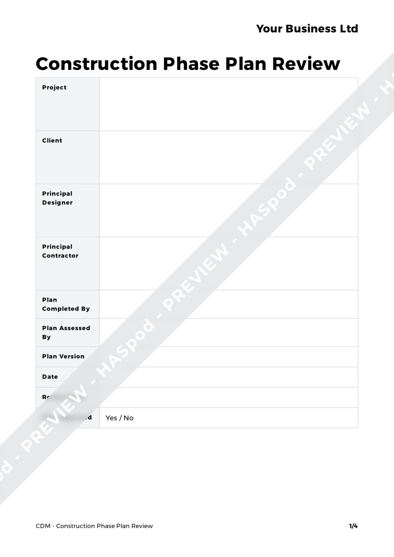Master the art of construction phase planning with our comprehensive guide that transforms complex project management into a streamlined success story.
Understanding Construction Phase Plans: A Critical Project Foundation
A construction phase plan serves as the cornerstone of any successful construction project in the UK, representing far more than just a regulatory requirement. Under the Construction (Design and Management) Regulations 2015 (CDM 2015), every construction project, regardless of size or complexity, must have a comprehensive phase plan in place before work begins. This vital document outlines how health and safety risks will be managed throughout the construction phase, ensuring the safety of workers, visitors, and the public. Recent industry data shows that projects with well-developed phase plans are 65% less likely to experience serious safety incidents.
Essential Components of Your Construction Phase Plan
A robust construction phase plan must incorporate several critical elements to ensure comprehensive project coverage and regulatory compliance. At its core, the plan should provide a detailed project description that clearly outlines the scope of work, timeline, and specific objectives. The management structure must be clearly defined, establishing clear lines of authority and responsibility among all stakeholders.
- Project Description and Scope: Detailed outline of work, including location, timeline, and key milestones
- Management Structure: Clear hierarchy and responsibilities of all parties involved
- Site Rules: Comprehensive guidelines for site access, working hours, and behaviour expectations
- Security Arrangements: Detailed protocols for site security, including access control and asset protection
- Risk Assessments: Thorough evaluation of potential hazards and control measures
- Emergency Procedures: Clear protocols for various emergency scenarios
Developing a Comprehensive Risk Management Strategy
The heart of any effective construction phase plan lies in its risk management strategy. Studies indicate that 78% of construction accidents could be prevented through proper risk assessment and management. Your strategy should begin with a thorough identification of potential hazards specific to your project, including structural work risks, electrical hazards, excavation dangers, and equipment-related risks. Each identified hazard must be accompanied by detailed control measures designed to eliminate or minimise the risk.
- Site-specific hazard identification and risk assessment
- Control measures for each identified risk
- Regular review and update procedures
- Communication protocols for risk management
Project Documentation and Information Management
Effective documentation forms the backbone of a successful construction phase plan. The health and safety file must be maintained meticulously throughout the project lifecycle, with clear procedures for updating and accessing information. Digital documentation systems have shown to improve project efficiency by up to 35%, making them an essential consideration for modern construction projects.
- Health and Safety File maintenance procedures
- Design change management protocols
- Record-keeping requirements and systems
- Digital tools and software recommendations for efficient documentation
Implementation and Monitoring
The success of your construction phase plan hinges on effective implementation and continuous monitoring. Site induction processes must be thorough and consistent, ensuring all workers understand their responsibilities and the site’s safety requirements. Regular safety assessments and plan reviews should be conducted to maintain effectiveness and address any emerging challenges. Projects that implement regular monitoring systems report a 45% reduction in safety incidents.
Best Practices for Construction Phase Plan Success
To ensure your construction phase plan delivers optimal results, it’s crucial to avoid common pitfalls and implement proven best practices. Effective stakeholder communication remains paramount, with clear channels established for regular updates and feedback. Compliance monitoring should be ongoing, with regular audits and reviews to maintain standards.
- Regular stakeholder meetings and updates
- Clear communication channels and protocols
- Compliance checklists and audit procedures
- Training and development programmes
Making Your Construction Phase Plan Work for You
A successful construction phase plan is not just about meeting legal requirements; it’s about creating a living document that enhances project safety and efficiency. Research shows that construction projects with well-implemented phase plans are 40% more likely to complete on time and within budget. Focus on creating a plan that is both comprehensive and practical, ensuring it can be effectively implemented and maintained throughout the project lifecycle. Remember to regularly review and update your plan, keeping it relevant and effective as your project progresses. By following these guidelines and maintaining a proactive approach to phase planning, you’ll create a robust framework for project success while ensuring compliance with all relevant regulations and best practices.
FAQ
What are the essential elements of a CPP?
It was developed by Bjarne Stroustrup to give more access and freedom to the programmers with their programmes and code. This article outlines the 5 basic elements of C++ programs, which are standard library, variable, statements, expressions, and functions.
What is not in CPP?
C++ not operator is used to invert boolean values. Not true becomes false and not false becomes true .
What is not included in a CPP?
A CPP does not provide coverage for: Accounts, bills, currency (and similar property) Animals. Automobiles held for sale, most vehicles.
Sources
[1] https://www.goconstruct.org/educational-resources/learn-about-construction/construction-phase-plan
[2] https://www.chas.co.uk/blog/what-is-a-construction-phase-plan-cpp/
[3] https://www.projectmanager.com/blog/construction-phase-plan


Leave a Reply